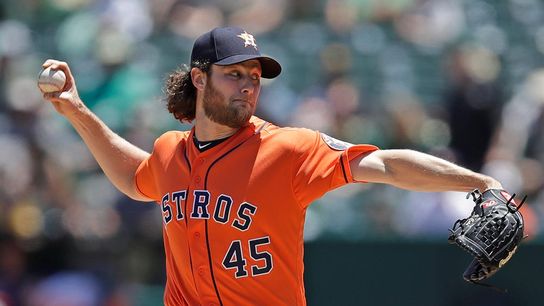Convincing a Pittsburgh sports fan to tune in to playoff baseball tonight may be a tough sell, especially when competing against the Penguins and Thursday night football. But if there is one pitcher billing that may get them to touch that dial, it is happening in Houston.
Gerrit Cole and Tyler Glasnow, the two highest profile starting pitchers the Pirates have produced this millennium, will square off in a do-or-die game five of the American League Division Series.
So expect a whole lot of this:
And this:
In case you need a reminder, the Astros got Cole for a package of Joe Musgrove, Colin Moran, Michael Feliz and Jason Martin in Jan. 2018. The Rays received Glasnow, Austin Meadows and prospect Shane Baz for Chris Archer at the 2018 trade deadline. Regardless of how you feel about any of those players, it is undeniable the Pirates sold low on their two pitchers. They could not figure out how to make either reach their ceiling. Houston and Tampa Bay did.
Cole's changes have been well documented over the past 18 months. He stopped throwing the two-seamer, instead opting for more four-seamers up in the zone and curveballs. 326 strikeouts later, we can safely say that was the right call.
Why didn't he do that in Pittsburgh? In The MVP Machine, by Travis Sawchik and Ben Linbergh, Cole said that when he went to Houston, the Astros, “highlighted the fact that my curveball’s my best pitch for me, which took six years for someone to finally tell me.”
Six years.
Glasnow's case seems to be even more cut and dry. Going to Tampa Bay gave him a renewed sense of confidence, thanks in large part to his locker partner, Blake Snell. He started to attack the strike zone, resulting in fewer walks and more chases.
Yes, there were some slight mechanical tweaks, like tightening up his curveball release, and he embraced the natural cut of his fastball rather than fighting it like he did with Pittsburgh. Those are minor changes that he could have fixed anywhere. It was clear the main problem in Pittsburgh was a bad environment for him mentally, and getting out may have saved his career.
In 2016, the Pirates called him up to the majors for the first time out of necessity. He was still visibly raw, but that was a forgivable sin. He struggled during spring training in 2017, partially because he was trying to develop a two-seamer, but he broke camp as the team's fifth starter. He was not ready for that leap, especially if he was going to throw sinkers, and he was smacked around by big league hitters for two months. After each start, Glasnow sounded more somber. It was clear his time in the majors was doing more harm than good. He was optioned to Triple-A in June, where he excelled once again.
Glasnow made the opening day team again in 2018, this time as a reliever. In that role, he pitched almost exclusively as a mop-up man. His talents were going to waste in the bullpen. While Cole was an All-Star in 2015 and a flawed, but overall above-average pitcher in 2016 and 2017, it had become apparent Glasnow would never pan out in Pittsburgh.
Did the Pirates learn anything from this? Maybe a little. Last year, the Pirates threw the sinker 15.3% of the time, a hair below the league average of 16%. It was the first time they threw a lower percentage of sinkers than the rest of the MLB since 2010, and it was the lowest percentage in the Neal Huntington era.
While they cut their percentage, still, their biggest mistake with a pitcher this year was making Archer start throwing a two-seamer. It did not go well. Out of the 204 pitchers across baseball who had at least 50 results with a two-seamer or sinker, Archer's .525 xwOBA was the worst. If you would prefer that in more traditional terms, batters had a .378 batting average and a .778 slugging percentage against it. The goal was to add vertical movement to his repertoire, but all it did was make a strikeout pitcher more hittable.
Archer ditched the pitch starting in his June 22 outing. In the 64.2 innings he threw up to that date, he had a 6.07 FIP. In his final 55 innings, sinker-free, he had a much more respectable 3.78 FIP. It was a step in the right direction, albeit a very late one.
The real change was seen with how the Pirates used their new next best hope, Mitch Keller. He did not throw a two-seamer all year, according to Baseball Savant. He pitched up in the zone more. He mixed in his curveball and newfound slider more than previous rookies had. They tried to keep him in the minors until they knew he would have a spot in the rotation. It also gave him more time to work on his slider in a lower stress environment. While he did do some bouncing between Triple-A and the majors because the Pirates needed pitching help, it was kept to a minimum. It's clear they are trying not to fall into the same pitfalls as they did with Glasnow and Cole. There is a lot riding on that right arm.
But if they do get into the same bad habits, Houston, Tampa and plenty of other teams will be waiting.
MORE MOUND VISIT
Oct. 8: Ex-Pirates of the postseason
Oct. 3: The year's worst balls/strike calls
Sept. 6: Frazier has fooled us again
Sept. 4: Hitters attack zone

